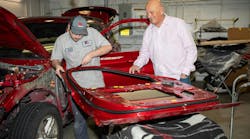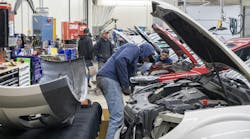Ron Nagy wanted to improve teamwork on the shop floor. So in 2004, the owner of Nagy’s Collision Center, which has four locations in northeastern Ohio and is on track to reach $5 million in sales this year, decided to switch from flat rate pay to a team-oriented plan. The idea “crashed and burned,” says Nagy, and shop dynamics cratered.
“The techs fought it, and it was a disaster,” he says. Techs began claiming co-workers weren’t pulling their weight or helping out when needed. To avoid an impending firestorm, Nagy quickly abandoned the new pay plan and reverted back to flat rate.
But Nagy was determined. So a year later, he tried a different approach. “After much research and preparation, we made the decision to simply switch to an hourly rate with an incentive bonus program. We did not even mention ‘team.’ Ironically, within three to four months, they were working closer as a team than I could ever imagine.”
PAY PLAN PROS AND CONS
Tony Passwater, a consultant to the collision repair industry, has been seeing some shops switch from flat rate to hourly. But he’s also seeing the reverse. He isn’t as quick as Nagy to credit the hourly pay plan with improved teamwork. “Hourly can encourage more teamwork, but not always,” he says. “Pure hourly without accountability or good management has not worked well in our industry.”
At the same time, Passwater says, “a pure flat rate/commission system has often been coined as a ‘lazy man’s way to manage production’ because it is believed by many that the tech will produce and strive to be efficient to make their paycheck.”
—Ron Nagy, Owner, Nagy's Collision Center
Passwater claims quality and teamwork come from the nature of the tech and good management. But he notes that there are several key differences between the pay systems that are worth considering: downside protection, upside benefits and job security.
“The flat rate/commission system protects the company from downturns in work: no work, no fixed labor costs,” Passwater says. “However, if there is no work, the techs look to go elsewhere (even out of the industry). This system also eliminates the upside potential since the techs still get the set commission when the work is pouring in.”
Pure hourly, on the other hand, “allows the company to retain the upside if they are able to manage the production well and get more production out of the techs than their hourly costs,” Passwater says. “This can encourage the shop to purchase time-saving tools and implement systems that improve efficiency, because they can gain from the investments.” Hourly can also give techs a sense of security, but it’s incumbent upon shop operators to manage well enough to not allow a tech to “drag on” to fill time, he says. “If done properly, techs could be sent home if their work load is low.”
Still, Nagy—who believes teamwork is essential for running a good business—says that when his techs were paid on a flat rate they were more easily isolated, which didn’t promote a sense of togetherness. “In order for the collision facility to work as a team, it must be an hourly pay plan. In my opinion, flat rate pay and ‘team’ are as opposite as oil and water.”
MAKING THE SWITCH
Clearly, making the switch from flat rate to hourly pay can be tricky. How did Nagy do it? First, he ensured that pay rates fairly reflected the technicians’ degree of experience. Nagy split each department into three categories: entry level, experienced and high level. “We determine the level at which each employee is at and what department they are in,” he says. “We review them quarterly to decide if they have transitioned to the next level.”
For example, here’s how Nagy pays techs at one of his locations: The head painter makes $23 per hour, with each workweek based on 45 hours (any hours over 40 are considered overtime). He made $68,066 last year with overtime and bonuses. The painter’s helper, with five years of experience, makes $13 per hour. She earned $38,606 last year with overtime and bonuses. A technician with experience earns $18 per hour and made $52,567 last year; one with less experience makes $13.50 per hour and made $34,592 last year. These numbers represent the high and low of each position.
VALUE-ADDED BONUS
Nagy found that adding a bonus program on top of the technicians’ individual hourly rates was a natural fit, as it strengthened a sense of teamwork and provided incentive for everyone to work together as efficiently as possible. It’s based on a two-level productivity system. “If they hit Level One [in terms of shop efficiency], it is a $100 bonus for each employee,” he says. “If they hit Level Two, it is a $500 bonus.”
After word of the shop’s unique bonus program got out, technicians at other shops became interested, and Sattler is now able to choose from top talent when recruiting.
Rydell Collision Center in Grand Forks, N.D., also offers a bonus program in conjunction with its hourly pay. The shop has paid hourly for 21 years, but body shop manager Randy Sattler added a bonus incentive four years ago, believing it would ultimately encourage technicians to have a bigger stake in the shop’s overall productivity and reward them for a job well done. Once the technicians learned to trust one another, their sense of teamwork solidified. Productivity—and consequently, the shop’s profitability—shot up. (The shop repairs nearly 18 cars per day and hits just over $4 million in annual sales).
In addition, after word of the shop’s unique bonus program got out, technicians at other shops became interested, and Sattler is now able to choose from top talent when recruiting. Better still, the shop’s monthly bonus program allows technicians to be recognized for their hard work and dedication.
Rydell’s bonus is determined by the number of labor dollars sold and number of dollars billed each month. Sattler calculated that the shop is not profitable until it hits $160,000 labor dollars sold, so bonuses don’t kick in until this number is reached. Once it is, he divides the number of dollars sold for that particular month by the total number of hours worked. For example, Sattler says that last month, the shop reached $166,000 in labor sales. The techs worked 3,511 hours. He divided $166,000 by 3,511 hours, which resulted in approximately $47.3 dollars per hour. Sattler then uses this amount to determine the “level” and percentage of a bonus that his technicians receive.
Here’s how the levels are determined: If an average of $41 is recuperated for every hour of labor, that falls under the “bronze” category and techs receive 2 percent of the total labor dollars sold that month. The silver category is $44 per hour and 2.5 percent; gold is $47 per hour and 3 percent; platinum is $50 per hour and 4 percent. So, based on this system, Sattler’s techs received a bonus of 3 percent of $166,000 last month. That created at pool of $4,980 to be shared among the 18 techs. Sattler kicked in a few extra bucks to keep the numbers round, and each tech received $277 over their expected pay. Updates are posted weekly so the team can keep track of their progress throughout the month.
MANAGING TEAMWORK
Although offering a bonus incentive is designed to reward technicians for their hard work, it’s not always a perfect system. Randy Sattler realized this early on. He often found himself running interference between grousing coworkers. Technicians suddenly began complaining that “Billy Bob over there isn’t working as hard as I am, and I’m turning more hours because I did six hours [of work], and he only did three.”
Fortunately, the problem can be fixed quickly. Good communication and frequent meetings helps keep everyone in line. “We explained to them that Billy Bob did three train wrecks, and you did six medium wrecks,” Sattler says. “[Or] maybe Billy Bob helped others on their jobs.” He also found that having daily morning meetings to go over everyone’s responsibilities helped to instill accountability among the technicians. “We go over everyone’s work load. By doing that, we’ve eliminated the finger pointing.”
BETTER BUSINESS, HAPPIER TECHS
For Nagy, switching from flat rate to hourly offered a huge benefit: “It’s no longer an ‘I, I, I’ attitude in our shop but rather a ‘we’ attitude,” he says. “We no longer have whining that certain techs are handed the gravy work. Since it’s a team effort, the techs’ concern is quality and efficiency.”
Sattler says technicians appreciate having a steady paycheck. “It doesn’t always come down to pure profit,” he says. “We wanted to pay [techs] a decent price so they didn’t have to worry during the slow times. In our world, they’ll always get a paycheck.”
The addition of a bonus incentive thanks techs for their hard work and dedication, Sattler says. “When the shop does well, they get to share in the profitability.”



